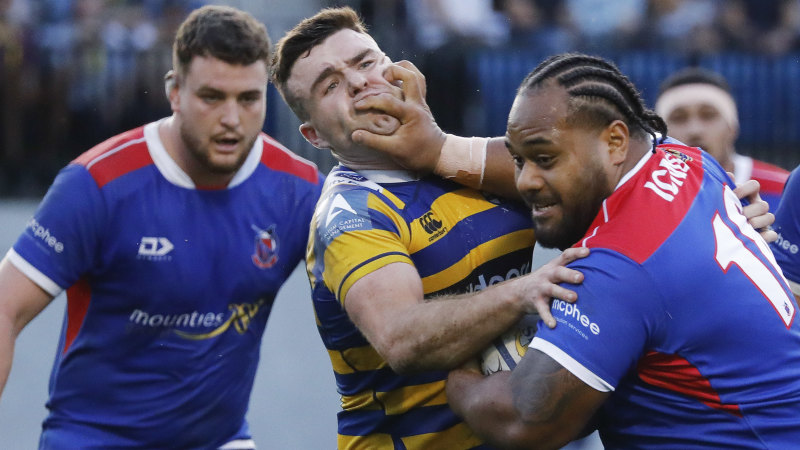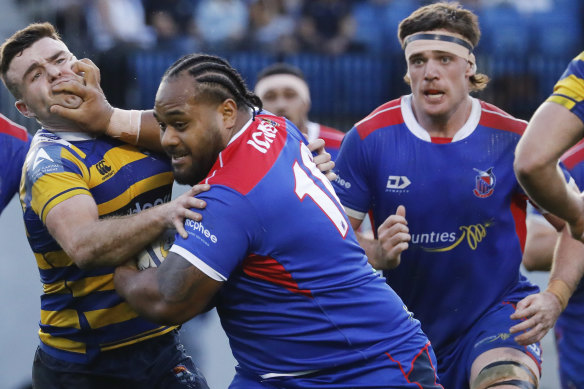
The great disconnect between grassroots rugby and Wallaby soap opera
October 20, 2023Save articles for later
Add articles to your saved list and come back to them any time.
On winter Saturday afternoons, you hear the roars through the trees. Big cheers come in waves, growing louder towards five o’clock when the games near their climax. At full-time, there are songs, laughter and almost-coordinated victory chants.
Rugby isn’t dead in these parts, Sydney’s northern suburbs, and it’s not gasping its last breath. This is not a particularly rugby area, but you only hear this kind of noise from sub-district and Shute Shield rugby. Not Aussie rules, not league, definitely not cricket. Sometimes soccer and netball get close. But it’s only union that generates this noisy passion.
Nor is it a private school thing. According to the Australian Sports Commission, 139,100 adults play organised rugby, so even though the game’s heart is not a big one, it still beats strongly. It’s played by labourers and drivers and security guards – rugby’s so-called grassroots. They don’t come from local state schools, where rugby has almost vanished, but state schools in New Zealand and the Pacific, and their involvement is through clubs rather than schools.
Although the Wallabies can be a conversation starter, the connection between the grassroots and the professional game is akin to tradies and The Block. The Wallabies, the World Cup and Eddie Jones are a TV show: sometimes entertaining, but a parallel universe with little or no connection to the rugby of the 139,100.
Where will rugby be in four years’ time? The TV show, the Wallabies’ version – well, that’s a worry. But the rugby for which the 139,100 lace up their boots for weekday training and weekend matches will be right here where you found it.
Rugby Australia’s fix is central control. But why would the 139,100 want to be under the power of that rabble? Would it bring more money for the local game? Doubtful, based on everything that’s come before. Would it connect a flow of talent from the suburbs to the top? Not likely. Rugby Australia, far from being a fix, is widely seen as having delivered rugby most of its current problems.
If you subscribe, you can watch the centralised rugby show. ICYMI, a few episodes ago the chairman centralised power in his own person when he came over the top of the entire organisation chart and personally appointed a new Wallabies coach. An all-or-nothing punt, it returned nothing.
When a gamble loses, the chips are usually lost by the gambler. Instead, the punter, Rugby Australia chairman Hamish McLennan, seems to have lost nothing except the respect of some rooms he walks into. But he seems to have a thick enough skin to handle being seen as a laughing stock. The real losses were absorbed by the Wallabies players, both the experienced ones who were dropped for the World Cup and the inexperienced ones who were taken. Then there were the TV viewers who suffered some late-night misery. The real unfortunates were the tour groups and travelling fans. Losing bets were paid out everywhere except where the gamble was made.
Manly and Sydney University face off at Manly Oval in the Shute Shield.Credit: Karen Watson
Centralisation is not just promoted by one isolated Shore old boy. There are two. RA chief executive Phil Waugh has taken an ‘ask no questions, hear no lies’ approach to Jones’s alleged conversations with Japan. Jones has treated his boss as he treats the media. ‘Mate, I don’t know what you’re talking about.’ For Jones, the media and officials have never really counted because they’ve ended up stabbing him in the back, so why would he owe them complete candour? A chief executive might then go to the Japanese identities alleged to have spoken with Jones, and done a little work. Instead, Waugh is leaving that to journalists. This is the body, Rugby Australia, that is asking for complete trust from the 139,100.
Trust is also begged for another Hail Mary, the signing of Joseph Suaalii for $5 million. In rugby league, Suaalii has shown sporadic ability to justify this valuation. Interestingly, his stand-out performances in league, during the 2022 World Cup, were when he followed his heart and played for Samoa. Suaalii will sell merch and tickets for the Wallabies. On the field, if he’s as effective a convert as Marika Koroibete then that would be terrific. Koroibete, a two-time John Eales Medal winner, has been outstanding. That said, he is only a winger. He has won one in four of the Wallabies games he’s played, and plays domestic rugby in Japan. From an outside back, that’s a best-case scenario.
In cutting Super Rugby teams, RA would be taking another of its big gambles. It has been here before, between the rock of five Super Rugby teams – diluted talent, poor results – and the hard place of cutbacks – the loss of angry fans outside Sydney and Brisbane.
Lack of money doesn’t help, but it shouldn’t hurt as much as it has. Even with $150 million over five years from Stan Sports and Nine (owner of this masthead), professional rugby runs on the smell of an oily rag compared with Australian rules and league, which hoover up the country’s most athletic and gifted ball-playing teenage talent. League and Aussie rules have the efficiencies, the organisation and the chequebooks. They also have the spectator appeal.
Say what you like about local versus global. If you were Ezra Mam, a cross-code schoolboy star, which would you prefer? Ply your wizardry in a game designed to showcase your skills 30 times a year? Or stand with your thumb up your arse watching scrums collapse, referees blow penalties, and tries scored from rolling mauls? Even if you’re doing it in Paris, London and Dublin, you’re still getting cold. The smart thing is to do a Suaalii: spend two years in your 20s seeing the world, pocket a few million bucks, then return to playing footy.
So. Where will rugby be in four years? The TV show will be up and down, mainly down, getting by on occasional false hopes and the infectious excitement of visiting international crowds. The 2027 World Cup will be spectacular, as it’s a world event that won’t depend on the Wallabies. Despite Eddie’s best efforts, professional rugby in Australia won’t be dead within four years. But it might be in 20.
On Saturday afternoons, though, the heart will still beat. Rugby’s base is strong and tight. The private schools will continue to invest, and First XV schoolboy encounters will be the pinnacle for some, and a pathway to the NRL for the best. Rugby Australia, meanwhile, will keep trying to sell its TV show. For the rural, regional and suburban grassroots, for the 139,100, the best thing the centre can do is let a little of its money trickle down to fund programs for coaching, ensure adequate facilities, provide assistance where it is required, and otherwise just get out of their way and stop embarrassing them.
Most Viewed in Sport
From our partners
Source: Read Full Article


